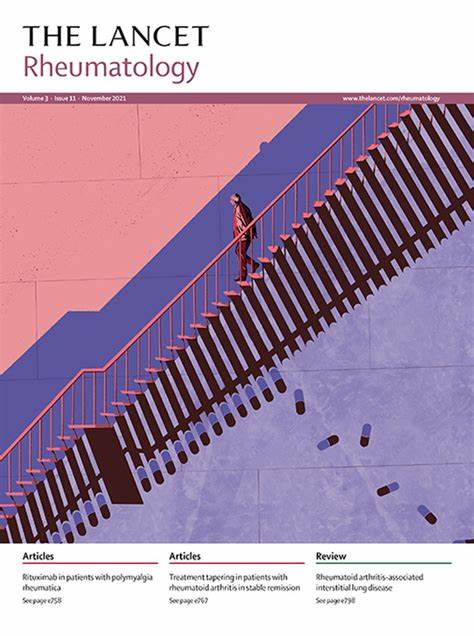一线生物与常规合成疾病改善抗风湿药物治疗在成人发病斯蒂尔氏病中的比较:一项多中心、回顾性、倾向加权队列研究
IF 15
1区 医学
Q1 RHEUMATOLOGY
引用次数: 0
摘要
背景:关于生物疾病修饰抗风湿药物(DMARD)疗法(如anakinra、canakinumab和tocilizumab)作为成人发病Still病(AOSD)的主要治疗选择的疗效的数据很少,治疗建议主要依赖于从儿科研究推断的数据。本研究的目的是比较一线生物DMARD治疗与常规合成DMARD治疗AOSD的有效性。方法:这项多中心、回顾性、倾向加权队列研究在德国16个二级和三级风湿病中心进行。符合条件的患者诊断为AOSD,符合Yamaguchi分类标准,并且没有当前治疗的活动性疾病。所有患者在第12周和第72周均有随访评估记录。主要终点是持续的无事件缓解;研究结果:在2007年1月1日至2022年9月30日期间,我们筛选了228名患者纳入研究。142例患者被排除,86例AOSD患者被纳入我们的分析,这些患者有偶发诊断或没有任何维持治疗,包括糖皮质激素。86例患者中女性50例(58%),男性36例(42%),白人84例(98%)。入组时平均年龄39.4岁(SD 15.4)。86例患者中有44例(51%)接受了一线生物DMARD治疗,42例(49%)接受了一线常规合成DMARD治疗。生物DMARD治疗与达到持续无事件缓解的主要终点的可能性更大相关(OR 7.20, 95% CI 2.50 - 36.64;p = 0·0007)。在第72周,持续无事件缓解率为50% (95% CI 34-65%;n=21), 12% (3-23%;N =5)为一线常规合成组。糖皮质激素相关并发症在一线常规合成DMARD组中更为常见(新发动脉高血压[n=2]和糖皮质激素相关皮肤病[n=3]),而在一线生物DMARD组中无并发症)。常规合成DMARD组42例患者中有3例(7%)死亡(2例死于巨噬细胞激活综合征,1例原因不明),而一线生物DMARD组没有死亡。解释:AOSD患者的一线生物DMARD治疗与持续、无事件缓解和更少并发症的统计学显著相关。我们的研究结果强调了与传统治疗方案相比,生物制剂在改善AOSD患者预后方面的潜力。资金:没有。本文章由计算机程序翻译,如有差异,请以英文原文为准。
First-line biological versus conventional synthetic disease-modifying antirheumatic drug therapy in adult-onset Still's disease: a multicentre, retrospective, propensity weighted cohort study
Background
Data on the efficacy of biological disease-modifying antirheumatic drug (DMARD) therapies such as anakinra, canakinumab, and tocilizumab as a primary therapeutic option in adult-onset Still's disease (AOSD) are scarce, and treatment recommendations rely mainly on data extrapolated from paediatric studies. The aim of this study was to compare the effectiveness of first-line biological DMARD therapy versus conventional synthetic DMARD therapy in AOSD.
Methods
This multicentre, retrospective, propensity weighted cohort study was done at 16 secondary and tertiary rheumatology centres across Germany. Eligible patients were diagnosed with AOSD, met the Yamaguchi classification criteria, and had active disease without current treatment. All patients had documented follow-up assessments at weeks 12 and 72. The primary endpoint was sustained, event-free remission; a combined endpoint of sustained remission (C-reactive protein <10 mg/L and no arthritis, rash, or fever) and absence of complications during follow up in patients treated with first-line biological DMARDs (with or without glucocorticoids) or conventional synthetic DMARDs (methotrexate or glucocorticoids). Analysis was by propensity score weighted logistic regression, thereby balancing for the initial Pouchot score, ferritin concentration, and age and sex differences between groups. Analysis was done in the per protocol population. People with lived experience were not involved in the study design. The study is registered with the ISRCTN registry, ISRCTN86135778.
Findings
Between Jan 1, 2007, and Sep 30, 2022, we screened 228 patients for inclusion. 142 patients were excluded, and 86 patients with AOSD who had an incident diagnosis or a flare without any maintenance treatment including glucocorticoids were enrolled and included in our analysis. 50 (58%) of 86 patients were female, 36 (42%) were male, and 84 (98%) were White. The mean age at inclusion was 39·4 years (SD 15·4). 44 (51%) of 86 had received a first-line biological DMARD and 42 (49%) received a first-line conventional synthetic DMARD. Biological DMARD therapy was associated with a greater likelihood of reaching the primary endpoint of sustained, event-free remission (OR 7·20, 95% CI 2·50–36·64; p=0·0007). At week 72, the rate of sustained, event-free remission was 50% (95% CI 34–65%; n=21) in the first-line biological DMARD group and 12% (3–23%; n=5) in the first-line conventional synthetic group. Glucocorticoid-related complications were more often described in the first-line conventional synthetic DMARD group (new-onset arterial hypertension [n=2] and glucocorticoid-related skin diseases [n=3]) versus none in the first-line biological DMARD group). Three (7%) of 42 patients in the conventional synthetic DMARD group died (two from macrophage activation syndrome, one unknown cause) versus none in the first-line biological DMARD group.
Interpretation
First-line biological DMARD therapy in patients with AOSD showed a statistically significant association with sustained, event-free remission and fewer complications. Our findings highlight the potential of biologics to improve patient outcomes compared with conventional treatment options in AOSD.
Funding
None.
求助全文
通过发布文献求助,成功后即可免费获取论文全文。
去求助
来源期刊

Lancet Rheumatology
RHEUMATOLOGY-
CiteScore
34.70
自引率
3.10%
发文量
279
期刊介绍:
The Lancet Rheumatology, an independent journal, is dedicated to publishing content relevant to rheumatology specialists worldwide. It focuses on studies that advance clinical practice, challenge existing norms, and advocate for changes in health policy. The journal covers clinical research, particularly clinical trials, expert reviews, and thought-provoking commentary on the diagnosis, classification, management, and prevention of rheumatic diseases, including arthritis, musculoskeletal disorders, connective tissue diseases, and immune system disorders. Additionally, it publishes high-quality translational studies supported by robust clinical data, prioritizing those that identify potential new therapeutic targets, advance precision medicine efforts, or directly contribute to future clinical trials.
With its strong clinical orientation, The Lancet Rheumatology serves as an independent voice for the rheumatology community, advocating strongly for the enhancement of patients' lives affected by rheumatic diseases worldwide.
 求助内容:
求助内容: 应助结果提醒方式:
应助结果提醒方式:


